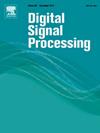基于时频分析与支持向量机相结合的中断采样中继器干扰抑制方法
IF 3
3区 工程技术
Q2 ENGINEERING, ELECTRICAL & ELECTRONIC
引用次数: 0
摘要
中断采样中继器干扰(ISRJ)是一种脉冲内相干干扰,严重影响脉冲压缩雷达的有效性。针对这一问题,本文根据脉冲压缩后ISRJ信号与目标回波信号时频分布的不同,提出了一种基于时频分析与支持向量机(SVM)相结合的ISRJ抑制方法。首先,利用高斯窗短时傅立叶变换(STFT)将雷达接收信号转换为时频域,提高了信号在时频域的分辨率;其次,通过离线训练随机样本集得到最优分类超平面,实现对目标和干扰信号的智能识别和分类;然后,采用z分数法消除目标脉冲压缩峰附近高干扰副瓣引起的离群点,进一步提高干扰抑制效果;最后,对处理后的时频矩阵进行短时傅里叶反变换(ISTFT),重建干扰抑制后的目标脉冲压缩结果。仿真实验验证了该方法具有较高的鲁棒性,与传统方法相比,具有更好的抗干扰性能。本文章由计算机程序翻译,如有差异,请以英文原文为准。
Interrupted sampling repeater jamming suppression method based on time-frequency analysis combined with SVM
Interrupted sampling repeater jamming (ISRJ) is an intra-pulse coherent jamming, seriously impairing the effectiveness of pulse compression radar. To address this issue, this paper proposes an ISRJ suppression method based on time-frequency analysis combined with support vector machine (SVM), on the basis of the different time-frequency distributions of ISRJ signals and target echo signals after pulse compression. Firstly, the radar received signal is transformed to the time-frequency domain using short-time Fourier transform (STFT) with Gaussian window, improving the resolution of the signal in the time-frequency domain; Secondly, the optimal classification hyperplane is obtained through training the random sample set offline, enabling the intelligent identification and classification of the target and the jamming signal; Then, the Z-score method is applied to eliminate outlier points caused by high jamming sidelobes near the target’s pulse-compressed peaks, further enabling the jamming suppression effectiveness; Finally, Inverse short-time Fourier transform (ISTFT) is performed on the processed time-frequency matrix to reconstruct the target’s pulse-compressed result after jamming suppression. Simulation experiments have validated the high robustness of the proposed method, demonstrating its enhanced jamming suppression performance compared to conventional methods.
求助全文
通过发布文献求助,成功后即可免费获取论文全文。
去求助
来源期刊

Digital Signal Processing
工程技术-工程:电子与电气
CiteScore
5.30
自引率
17.20%
发文量
435
审稿时长
66 days
期刊介绍:
Digital Signal Processing: A Review Journal is one of the oldest and most established journals in the field of signal processing yet it aims to be the most innovative. The Journal invites top quality research articles at the frontiers of research in all aspects of signal processing. Our objective is to provide a platform for the publication of ground-breaking research in signal processing with both academic and industrial appeal.
The journal has a special emphasis on statistical signal processing methodology such as Bayesian signal processing, and encourages articles on emerging applications of signal processing such as:
• big data• machine learning• internet of things• information security• systems biology and computational biology,• financial time series analysis,• autonomous vehicles,• quantum computing,• neuromorphic engineering,• human-computer interaction and intelligent user interfaces,• environmental signal processing,• geophysical signal processing including seismic signal processing,• chemioinformatics and bioinformatics,• audio, visual and performance arts,• disaster management and prevention,• renewable energy,
 求助内容:
求助内容: 应助结果提醒方式:
应助结果提醒方式:


